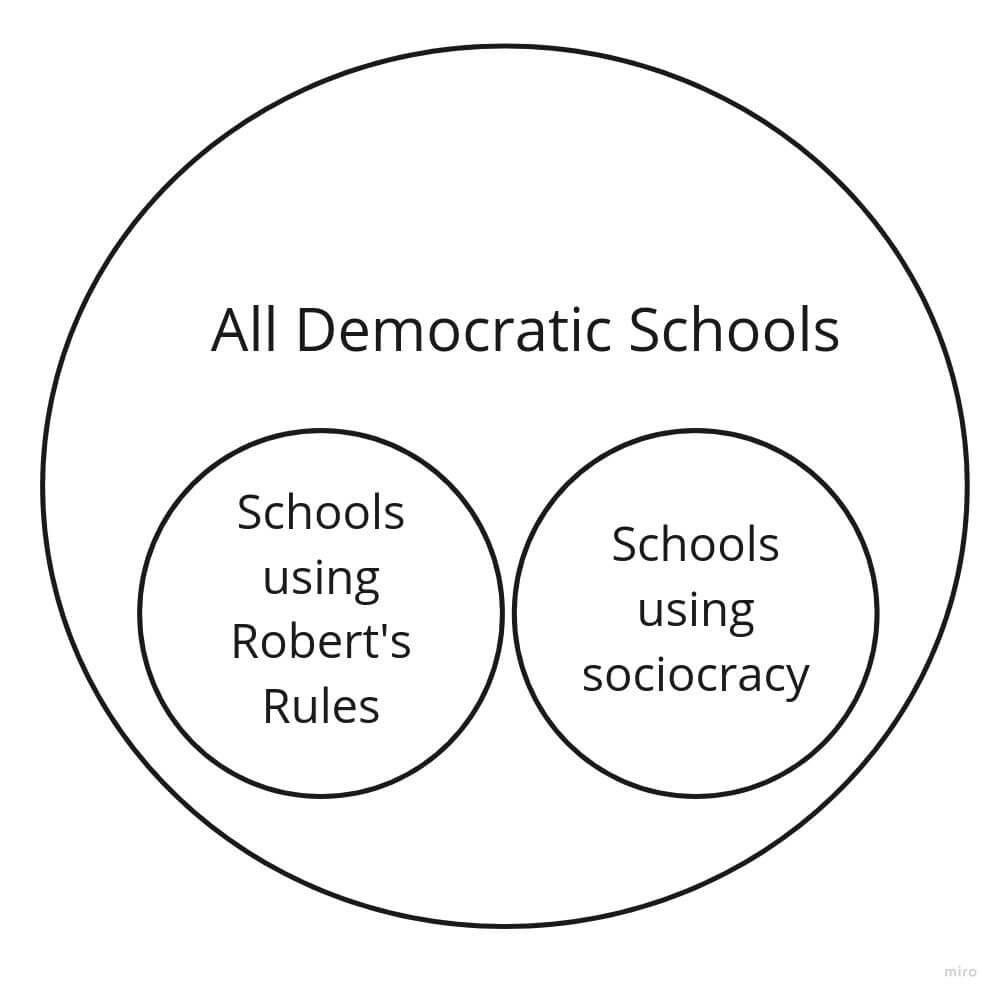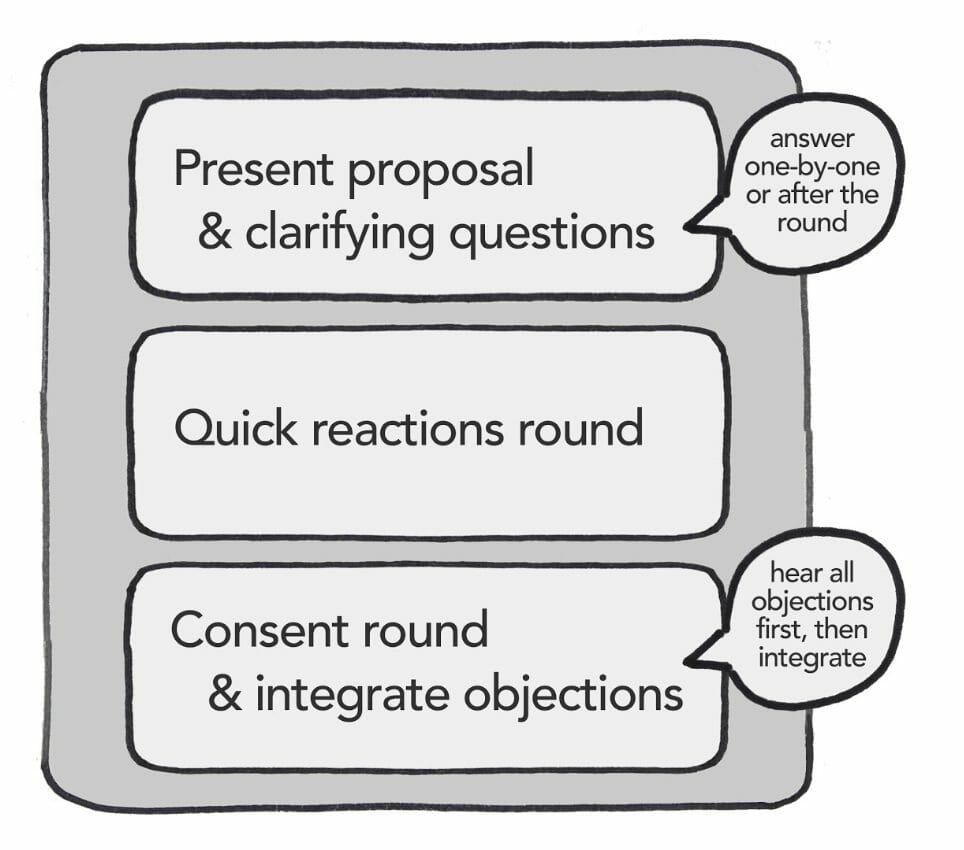Originally published at: https://www.sociocracyforall.org/comparing-roberts-rules-and-sociocracy/
How Consent Decision-Making Solves Some Problems From Parliamentary Procedure
Voting via majority rules is just one way to participate in decision-making.
A Tense Meeting Using Robert’s Rules of Order
I vividly remember sitting in the democratic school meeting room as the emotional tension built. I had been attracted to democratic free schools as they empower children to make decisions about their lives. These decisions include what they learn, making the school’s rules, to even electing the staff. Democratic schools have regular school meetings where adults and children have equal votes. This particular meeting used the standard Robert’s Rules of Order, with raising hands to speak, and majority rules voting. The topic up for a decision was whether some comments left on a wall could be considered transphobic and violating the rights of students. The students split on whether it was a joke to be considered free speech, or something offensive. They debated fiercely, and feelings were running high. When it came down to a vote, the side that believed it was a joke narrowly won. Some of the students left in tears. We spoke in the hallway, and I found that they felt like their voices didn’t matter and they hadn’t been listened to. As I listened to them I felt knots in my stomach about how things had gone. I strongly believed in democratic education, but I didn’t like the process or the outcome. I could see that the school was torn apart and that the vote hadn’t really resolved the issue at hand.
A More Relaxing Sociocratic Meeting
Over a year later, as I was in a meeting at a school using sociocracy, I was having flashbacks.
The topic at hand was again profanity and hate speech. We talked in rounds with each person taking a turn, and people shared their opinions on the matter. As everyone talked, the issue became more clear. The students saw profanity as freedom of speech but one that needed to be balanced with the right to be free from profanity as well. Profanity could be used with consent in private spaces, but hate speech would not be allowed at all. The students decided that hate speech would be defined by the community as any speech that any member found offensive. We put a term limit on the decision to check in and see if it was working.
While considering this decision, the room felt orderly and each person spoke calmly in turn. I couldn’t help but think of the difference between the two meetings. I felt much safer during the sociocratic meeting as opposed to the one using Robert’s Rules of Order. We did a round of reflections on how the meeting went, and the students were happy with the outcome.

Democracy vs Sociocracy
The word democracy comes from the Greek “demos”, and is the shared rule of the people. Democracy is a larger category of which majority rules is only one subset. Sociocracy derives from “socios,” and means “the rule of the associates.” Sociocracy is one form of democracy as it could be. When I heard about sociocracy, I fell in love with the idea that decisions were made by consent. Consent decisions take into consideration the voices of everyone affected by the decision. This was very appealing to me as I had seen times when so many people were unhappy with the results.
Consent Decisions vs Robert’s Rules Majority Vote

Consent is very different from Robert’s Rules-style majority rules vote. Consent decisions are made in smaller groups of six to eight people in interconnected circles. People speak in rounds instead of raising their hands to be put on a list to speak. During rounds, people are only speaking to their own opinions and are not debating. The biggest difference is that everyone gets a chance to speak, not only the person making a proposal or those who have strong opinions. This process includes the voices of the quiet as well as people who are more comfortable speaking up.
In Robert’s Rules parliamentary procedure, either you are for a proposal, or against it. There is room to amend proposals, and this often happens. But the ultimate answer is “yes” or “no.” In sociocracy, there is a wider range of tolerance to decision-making. Your preference, or “yes,” is still included, but consent also includes “I don’t agree with it, but I can tolerate it.” Decisions are seen as “good enough for now, and safe enough to try” for a limited time period, after which decisions are evaluated. If you see some danger, or if the proposal is unclear, you can object to the proposal.

In sociocracy, a proposal is presented for clarifying questions. Next, there’s a quick reactions round for people to say what they think about the proposal. The final round is a consent round where people who have any objections to the proposal can speak up. Objections are valid if there is any reason that the proposal isn’t good enough for now or safe enough to try. It’s not merely a personal preference. This way of making decisions is actually quite quick and efficient. There is sometimes more discussion beforehand but it evens out in the long run. Everyone who has a stake in a decision has a voice, which makes new policies easier to implement. Harvesting the objections is a way to amend the proposal and make it even better. In a majority vote, though it may go very quickly, the minority may feel unhappy, and may even work actively against the proposal.
Consent Decision-Making In Practice: Empowering All Voices
One time I saw consent decision-making work was when students planned an end-of-the-year school celebration. Younger students wanted to rent an inflatable bounce house for an end-of-year party. Older students objected that it would not be safe because there were too many students to fit in the bounce house. In a majority rules situation, the two sides would fight against each other, bounce house vs no bounce house, and one side would lose. Instead, the students incorporated the objections about safety into the proposal. They decided that it would be better to go to a local trampoline park on a field trip. That way, everyone could have fun, while still being safer than in a crowded bounce house.
I wholeheartedly support all forms of empowering young people. I wish for the further democratization of schools and workplaces in my lifetime. As a school leader using sociocracy, I believe that consent decision-making solves many of the problems of Robert’s Rules. It doesn’t take a long time to look around to see in our society how a narrow 50/50 vote can leave half of the country feeling left out and sow deep divisions. In the consent-based decision system, the group brings out the best of what everyone has to offer. Working towards consent helps bring everyone together toward common ground.
Featured photo by Element5 Digital from Pexels.
Want to learn more about the decision-making process in sociocracy? Check out our training and events page!
